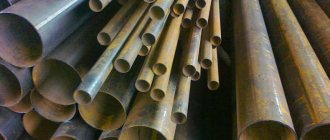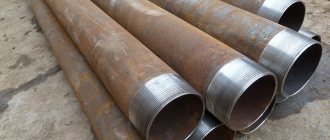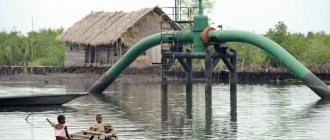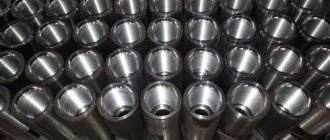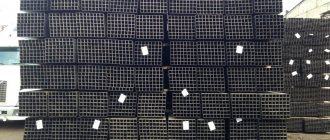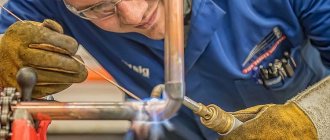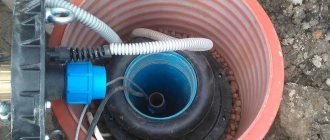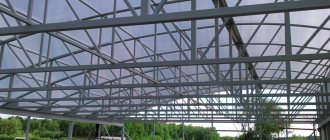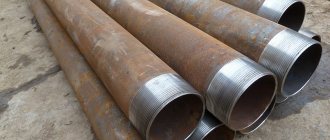Tubing is used to extract minerals using drilling rigs. They can also be used to create compact small artesian wells. They may differ in length, wall thickness, material, and so on. Preservation, storage and transportation of these parts must be carried out in accordance with the GOST standard. This will increase the shelf life of the products, making them more durable and reliable. But why do we need tubing? How much does a standard tubing pipe weigh according to GOST? And how to properly store these parts in a warehouse? These issues will be discussed in the article.
Operating principle of drilling rigs
To understand the purpose of tubing, you need to know the principle of operation of drilling rigs. Drilling rigs are used to extract water, gas and oil, which are located deep underground. They differ from each other in many parameters - operating principle, design, performance characteristics and others. Typically, a drilling rig consists of three elements - an aboveground platform, a drill string and a power system. The installation may also include additional elements - a controlling pneumatic drive, a drill cooling system, warning sensors, and so on.
Drilling technology
- At the preparatory stage, geologists conduct exploration and outline the proposed drilling location. Then the drilling platform is mounted and a test run of the installation is performed. During the test, the following parameters are checked: the quality of the joints of parts with each other, the level of vibration, and the level of load on the electric motor.
- If everything is fine with the platform, a well is drilled. For drilling, a drill string is used, which is connected to an electric motor. At the end of the column there is a sharp tip-chisel, which destroys hard rocks.
- During operation, the drill string rotates along its axis, which leads to the formation of a well. At the same time, the waste soil is supplied to the surface. Modern rigs are equipped with a system for supplying protective chemicals, which minimizes the risk of damage to the drill string.
- After creating a well, it is necessary to fix it. To solve this problem, two technologies can be used. In the first case, an additional pipe is installed in the well, which creates a gap between the column and the pipe itself. Soft mixtures are poured into this gap and quickly harden. In practice, this method is rarely used. In the second case, a casing pipeline is installed in the well, which has thick walls and can withstand any load.
- After strengthening the well, pipes are inserted into the casing to pump out minerals or water. Tubing can be used as such a pipe. Before they are introduced into the well, they are secured using well couplings, which turn the individual tubing pipes into a single compression string. To extract minerals, an electric motor is started, which pumps oil or gas from the well to the surface. On the drilling platform, minerals are packed into containers (barrels, tanks, vats).
Please note that tubing can be used in other scenarios. A simple example: a pipeline can be configured not to suck in liquids, but to spray them. This technology allows for the injection of liquids, which can be useful in some areas of human activity. Examples - well repair, geological exploration, local increase in pressure, creation of additional inflows to the main well.
GOST requirements
The tubing pipe is used to transport liquid and gaseous substances from wells to the surface. In technical terms, they are ordinary seamless pipes. According to GOST, they must have the following properties:
- High strength. During operation of the production platform, liquids and gases will flow through the pipeline under pressure. It is necessary that the pipeline installation retains its strength and does not crack. Even small leaks or cracks will lead to complete depressurization of the installation, which can lead to failure of the entire platform.
- Tensile resistance. Most modern wells are not completely straight. This is caused by various reasons: shortcomings in drilling, changes in the shape of the well due to the movement of the earth, and so on. It is important that the pipes retain their shape and do not crack when bent. In case of low tensile strength, the column may leak, which will lead to the destruction of the system.
- Density, tightness. The material from which the pipeline is made must be dense and airtight. This factor is especially critical for the ends of the installation that will be threaded. If the material is plastic, the thread will be of poor quality. Because of this, the tightness of the seams will be compromised, which can lead to depressurization of the system.
- Corrosion resistance. A large amount of liquid or steam will flow through the pipeline while the drilling rig is operating. This can cause rust to form, causing the pipe string to fail. For the manufacture of tubing, high-carbon steel is used, which contains chromium-based alloying additives. This component prevents the formation of rust and also stimulates the formation of a protective oxide film on the metal surface. Thanks to this, the installation does not crack or rust while the tower is in operation.
Some features of the production of tubing pipes and their acceptance tests
Various materials can be used to produce pipes used to transport liquids and gases from production wells.
Fiberglass
Pump and compressor pipes made of this material are used to equip disposal and injection type wells. As a rule, electric centrifugal pumps (ESP) are used in combination with such tubing.
Steel
The most common steel grades used for the production of tubing pipes are 30ХМА, 30, 20. If finished steel pipes intended for use in wells have even the slightest deviation from GOST requirements, they are sent for remelting.
Alloys containing aluminum
The use of this metal in tubing pipes provides them with high resistance to corrosion, including hydrogen sulfide, and can significantly reduce the weight of the entire structure.
Regardless of what material the tubing pipes are made of, many manufacturers additionally apply special protective coatings to their internal walls. Special varnishes, epoxy resins and liquid glass can be used as such coatings, which can significantly increase the service life of pipelines and protect them from deposits on the walls. The use of protective coatings for tubing pipes is an economically feasible solution, which results in reduced operating costs as well as repair costs. Considering the fact that stainless steel is not used for the production of tubing pipes, the use of special coatings is the only option for protecting well pipelines.
Reception walkways for tubing pipes
To ensure that tubing pipes fully meet their intended purpose, their characteristics are carefully controlled at all stages of production. In particular, the following parameters are checked:
- resistance to sulfide corrosion cracking;
- hardness;
- tensile strength;
- water resistance;
- impact strength of the manufacturing material.
It is important that the pipe can be approved for use only if it meets all the requirements for it. Otherwise, the finished product is sent for processing.
Functions, features of tubing
The main functions of pumping and compression pipelines are the extraction of liquids and gases from wells, maintaining reservoir pressure, and major workover of wells. The starting material is usually steel with a medium or high carbon content. Other materials can also be used - plastic, aluminum, copper + various alloys. Such pipeline systems will have low strength, so tubing made from these materials is used only in the case of small wells (dacha plots, small artesian wells). For mining, pipes are attached to each other to form a single column.
The following technologies are used to connect individual elements to each other:
- Threaded connection. This technology is applicable only if the ends of the pipes have threads (applied at the factory). To connect two separate parts, a tubing coupling is used, which has an internal thread. To connect, the ends of the pipelines are cleaned using polishing tools. Then the tubing coupling is screwed onto one pipe (half the thread). After this, the second tubing pipe is also screwed into the coupling. If necessary, additional adjustments are made to the parts to ensure a tight connection.
- Welding or soldering. This technology is used if the ends of the pipes do not have threads (or their quality is low). To connect, the parts are placed close to each other - then they are connected using a welding machine. Any welding method can be used - automatic, semi-automatic, electric arc method and others. The main difficulty in welding is that the piping parts are usually made of steel. Therefore, the ends will have to be heated to high temperatures, which complicates the technical procedure. In practice, welding technology is rarely used due to its complexity.
Tubing pipe weight
The weight of the tubing pipe depends on three parameters - overall diameter, wall thickness and typical length. Compression tubing tubing73-5.5 and tubing tubing89-7 are popular - the numbers indicate the cross-sectional diameter and wall thickness. Long, thick-walled pipes have a lot of weight, while short, thin parts will have little weight.
| Section diameter (mm) | Wall thickness (mm) | Typical length (m) | Approximate weight (kg) |
| 73 | 5,5 | 2 | 19 |
| 73 | 5,5 | 3 | 28,5 |
| 73 | 5,5 | 4 | 38 |
| 89 | 7 | 2 | 29,5 |
| 89 | 7 | 3 | 44 |
| 89 | 7 | 4 | 58,5 |
Features of installation and operation of columns from tubing pipes
A notable feature of pipes for transporting liquids and gases from the productive zone is that during operation they can be repeatedly (2-3 times) removed from the well, as well as carried out repairs and maintenance. This feature must be taken into account when designing tubing columns, which are formed from several pipes connected to each other by means of sealed couplings. Specialists performing such design must take into account the fact that the columns must be installed efficiently, quickly and safely and also removed from the well, and be able to be installed back if necessary.
Types of tees and elbows for tubing
If necessary, several columns can be installed in one production well, but experts try to limit themselves to a maximum of two tubing columns. Of greater importance for designers is the ability to equip a well with pipes that can be used for as long as possible without labor costs for repairs or replacement.
An important feature of columns made from tubing pipes is the ability to use them not only for their intended purpose, but also to solve a number of other problems. Thus, tubing combined into a string and placed in a production well allows solving the following important problems:
- carrying out acid work, detecting an aquifer, performing testing activities, measuring pressure in the well;
- perforation of the productive horizon;
- reducing the risk of increasing pressure in the annular space formed by the outer walls of the tubing and the internal walls of the casing (with a sharp increase in such pressure, the tubing string ensures release of the blowout to the well surface).
Construction of wells with tubing
Based on the purpose of tubing columns, a number of requirements are placed on them. So, they should:
- have high strength and withstand significant tensile loads;
- provide the required characteristics of liquid or gas flow;
- can withstand loads well when performing various types of work (acid treatments, hydraulic fracturing operations, etc.);
- maintain the required pressure of a liquid or gas when transporting it through a pipeline;
- have high erosion and corrosion resistance throughout the entire life of the well;
- be equipped with couplings that can withstand compression and tension loads for a long time, eliminating the risk of leaks.
Compliance with these conditions allows you to extend the service life of the columns to 20 years and eliminates the labor-intensive work of removing it from the well.
Features of operation and storage
Let's consider some features of the operation and storage of tubing:
- Using lubricant. Before installing the tubing string, it is necessary to lubricate the end of the tubing with a protective lubricant. The type of lubricant depends on the nature of the well, the type of casing and the category of metal from which the pipeline is made. The lubricant must be applied carefully in accordance with the dosage rules. A lack of lubrication or its excess negatively affects the strength of the structure and also complicates its installation.
- Welding protective environment. Soldering should be carried out in a protective environment (argon). If shielding gas is not used, there is a risk that the metal edges of the part will be damaged during welding. This seriously increases the likelihood of corrosion, which will lead to deformation and cracking of the pump string.
- Removing a pipe from the system. In case of prolonged downtime of the drilling platform, it is necessary to dismantle the tubing. After all, the edges of the pipe are in constant contact with the liquid medium, which can lead to corrosion. After dismantling, it is necessary to rinse the installation and lubricate it with protective lubricant. Check for damage, cracks, and corroded areas.
Tubing pipes can be stored in any cool, dry place. It is better to pack them in special blocks made of wood, plastic and metal. It is best to store such units in a warehouse with good ventilation. In accordance with GOST rules, each spare part must be marked. It should contain all the important data about the part - markings, type, brief information about the manufacturer, information about the workers responsible for its production in the workshop. Blocks with pipes can be transported in any convenient way (using trucks or trains, planes, water transport, and so on). In the event of a sale at the request of the buyer, control procedures must be performed to prove that the parts are in proper condition.
Types and characteristics of pumping and compressor pipes
The main function performed by tubing is to transport gases and liquids produced in the productive zone to the well surface. In addition, tubing acts as a kind of insulator that protects the gas and liquid transported through it from the well walls, and also prevents the occurrence and development of corrosion, paraffin and asphaltene deposits on the casing pipes. The tubing pipe placed in the well is also necessary to ensure the carrying out of tripping and repair work, which is regularly needed.
Taking into account all these factors, it becomes clear that tubing during its operation experiences significant loads and is in constant contact with aggressive environments, which determines serious requirements for their quality.
Such requirements include, in particular:
- high permeability even in areas of wellbores characterized by strong curvature;
- exceptional tightness of the joints between tubing products;
- wear resistance and the ability to withstand even significant mechanical stress;
- high strength of both the manufacturing material and the product itself.
Subs for drill string and tubing
First of all, casing is installed and secured into the well with cement, and only then the pump and compressor pipes. To perform this operation, special fixing elements called packers are used. The length of individual pipes used to transport gas and liquid from a well can be up to 11.5 meters, and couplings are used to connect them to each other, ensuring the tightness of the joint and its reliability. Tubing differs in the diameter of its cross-section; this parameter can range from 50.8 to 139.7 mm (2–5.5 inches).
Pipes for transporting liquids and gases from wells are classified according to various parameters. One of these parameters is the type of pumped fluid, depending on which tubing can be used in wells:
- gas and water injection type;
- for transportation of heavy oil (bitumen) from the productive zone;
- gas producers;
- oil
Enterprises that produce pumping and compressor pipes are guided by the requirements of GOST 633-80, according to which such products are divided into three types.
Tubing connection with coupling
- Smooth coupling products, the threads of which have a conical type and a triangular thread profile. Tubing of this type is characterized by increased cold resistance and ductility.
- Smooth products, the design of which is complemented by a sealing unit made of plastic.
- Coupling-type products, the conical threads of which have a trapezoidal profile. Tubing of this type is characterized by high tightness.
- Smooth coupling products, the threads of which have a conical type and a triangular profile.
In different countries there are analogues of this GOST, according to which pipes are divided into the same types. In particular, in the USA and a number of other countries such a regulatory document is the API 5CT standard.
Production technology
Tubing pipes are made in several stages:
- Manufacturing of standard type pipes. After smelting the metal, a hollow semi-finished product is formed, which ends up in the pipe-rolling shop. Here, a full-fledged part is formed from a blank using the cold or hot rolling method. At the end, the part is hardened and cooled (if necessary). If the spare part will be stored in the workshop for some time, then intermediate marking will be applied to it in accordance with GOST rules.
- Preparatory work. Now the finished pipeline part enters the production workshop. Here the spare part is degreased and then cleaned. Grinding equipment is used for cleaning; manual processing is rarely used due to its low efficiency.
- Threading on one end. After treatment, control ultrasonic flaw detection is performed. If everything is fine with the spare part, a thread is applied to one of its edges using special tools. Immediately after applying the thread, repeated flaw detection is carried out, which makes it possible to determine the quality of the thread. If all is well, a tubing coupling is mounted on the end of the part. Then the installation is cleaned with water.
- Threading the second end. Now the worker uses tools to apply threads to the other end of the part. Then he performs control flaw detection, and the check is performed twice, since a protective coupling will not be mounted on this end. If everything is fine with the spare part, a protective casing-protector is screwed onto the thread.
At the end, final processing, packaging, and transportation are performed. Upon completion of all work, the finished spare part is washed and checked for defects, damage, and scratches. Control weighing is also carried out and GOST markings are applied. If all is well, the spare part undergoes a preservation procedure. Finally, it is packed into metal, plastic or wooden blocks for storage in a warehouse.
Kinds
There are two types of pump and compressor products according to GOST 633-80, which are produced with significant differences in the structure of the ends: they can be made smooth, or with external threads. If the ends are set outward, this allows a device such as a coupling to be screwed onto the part. The lubricant that is applied to the thread acts as a sealant and anti-corrosion coating.
Characteristics of strength groups of tubing pipes
Decryption
The marking, located approximately half a meter from the edge of the product, contains information about its diameter, what strength group the steel belongs to, its thickness, the product mark, and the date of manufacture. Smooth products and couplings provided for them are made from steel belonging to strength groups K, E, L, M. Threaded parts are made from steel of the following groups: D, K, E, L, M. The length of the products produced ranges from 6 to 10.5 m. Sometimes pipes are made whose length reaches 11.5 m. The diameter of the tubing is in the ratio with the parameters of their walls: • thickness 0.3 cm d -27 mm; • thickness 0.35 cm - d - 33 and 42 mm; • thickness 0.4 cm - d - 48 mm; • thickness 0.5 cm d - 60 mm; • thickness 0.67 and 0.7 cm - d -73 mm; • thickness 0.8 cm - d - 89 mm; • thickness 0.65 cm - d - 102 mm; • thickness 0.7 cm - d - 114 mm.
steel grade
Coupled tubing has a number of varieties, depending on what cross-section they have, the presence of threads, the properties of what they are made of, etc. For both types of pipes, according to the criterion of the structure of the ends, smooth and coupling, the tightness of the connection is guaranteed at a pressure of up to 50 MPa. This is achieved thanks to the seal (for smooth ones). By means of a trapezoidal thread, both types are connected. It is necessary to note certain advantages of products made from alloys containing aluminum. They are less susceptible to corrosion, and their low weight contributes to higher specific strength values than steel ones. Often, pump and compressor parts are coated with a special protective layer. This helps prevent corrosion and deposits. The choice of this product prolongs the maintenance-free operation of the column. To cover the inner surface, enamel, varnish, resin are used, glass coating is the most popular option.
We recommend: How to cover pipes with blinds in the bathroom and toilet
